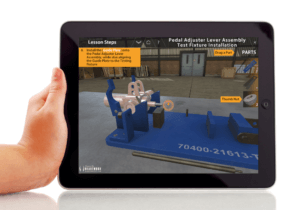 Virtual 3D Interactive training is no longer the ‘new tech’ it once was. We see it being used in diverse industries – Manufacturing, Heavy Equipment, Aerospace, Food Packaging, Automotive, Defense, Oil & Gas, Energy, Utilities and more. These companies are seeing pretty significant ROI in deploying it as a visual, interactive and portable means to train their distributed workforce.
Virtual 3D Interactive training is no longer the ‘new tech’ it once was. We see it being used in diverse industries – Manufacturing, Heavy Equipment, Aerospace, Food Packaging, Automotive, Defense, Oil & Gas, Energy, Utilities and more. These companies are seeing pretty significant ROI in deploying it as a visual, interactive and portable means to train their distributed workforce.
So the question has moved beyond ‘whether or not’ to adopt 3D interactive training to something more tactical: “Should we Build a team in-house or Partner with specialists?”
And we have insights to share from some of our customers who have debated this internally. They’ve been kind enough to share their discussion framework and thoughts, which follows:
Multiple Assembly-line Skillsets Needed
 Any application development needs professionals spanning a variety of disciplines, and a virtual training-focused application just adds to those requirements. A professional training app development pipeline should include:
Any application development needs professionals spanning a variety of disciplines, and a virtual training-focused application just adds to those requirements. A professional training app development pipeline should include:
- User Experience (UX) Designers
- Instructional Designers (O&M training focused)
- 3D Artists
- User Interface (UI) Designers
- Game Engine Programmers
- Testers (De-bugging)
Challenge to Consider: While these skills/professionals are critical to your pipeline at a point in time, you do not need all of them throughout the life cycle of project. This can leave you with lots of down-time and overhead, which can greatly reduce your ROI. Be sure to compare that against the fixed cost of engaging a specialist team.
Learning Curve and a ‘Mountain’ Of Code
Hiring personnel does not equate to a producing team. It takes years to develop processes, systems and most importantly, custom internal tools to build 3D simulation-based training. The apps we develop for our customers (like you) are built using a code base of millions of dollars of invested time and research. Eureka moments and mistakes made in the past are pre-baked into anything new we build today and that advantage is passed on to our customers.
Challenge to Consider: A fair estimation would have a new team devoting 7 years and/or 150 applications before they would reach specialist experience level and possess any sort of IP advantage. And by that time, a whole new cycle of learning and code base would have begun at an existing firm, so they would face a steep learning curve for some time.
Focusing on Core Strengths
Companies know their problems well and their SME’s (Subject Matter Experts) are invaluable. Use that precious resource to ‘direct’ the development and leave the actual ‘acting’ to a specialized crew. Diversifying into new skill-sets is not a good use of resources unless strategically that is where the company wants to specialize in.
Challenge to Consider:For example, companies that make Diesel Engines are trying to build them better and sell them better. They are better served focusing on those functions and leaving the training simulations to the simulation experts. Simply put, better to develop a better engine or corresponding core solution than devote design resources to training development.
“If you want to go fast, go alone. If you want to go far, go together.“
– African Proverb
Inevitable Trends
As a company that builds simulation-based training for a variety of industries and customers (Manufacturing, Heavy Equipment, Aerospace, Food Packaging, Automotive, Defense, Oil & Gas, Energy and Utilities), we benefit from seeing cross-industry trends that in-house teams miss when focused only on an internal customer base. For example, we are in R&D phases with technologies that are not fully ready, but inevitably will be:
Analytics (of trainees) – using Big/Medium Data for key training insights.
AR/VR/Mixed reality – hard to read anything these days without coming across one of these.
AI/Deep Learning/Machine Learning – being used in games already and should crossover into simulations.
As we incorporate these into our applications, your training will benefit from the R&D investment that Heartwood is making.
Challenge to Consider: Devoting resources to creating training internally could result in training that takes only known variables into account. Unless your internal team is exposed to a variety of possibilities, there’s no way for them to account for the latest trends taking place in the industry short of devoting that many hours to that pursuit. And does that activity make sense for your training budget or is it money best spent elsewhere – like on developing the actual training with specialists?
Reach out here and we can explore your unique situation in detail!


